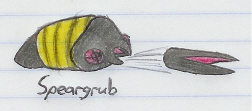Speargrub
('spir-grәb)
Family: Mandiblard
Binomial Nomenclature: Himeagea ensnarulus
Habitat: ???
Size: 25mm
Weight: 1 g
Attacks: Fires mandibles, sucks mandibles back to itself (with prey in tow) or burrows underground and comes up under trapped prey. If mandibles are broken, it becomes helpless.
Speargrubs travel in packs, often with other members of the Scarpanid family. From millions of years of evolution they have learned how to exploit the concept of crossfire by surrounding potential prey. Speargrubs are able to fire their mandibles at prey, trapping and occasionally impaling it. A Speargrub's specially formed pupils allow it to target other creatures, though they tend to be poor aims...
In the larval stages, a Speargrub's mandibles fall off after its secondary mandibles have grown too big. Females of the species will leave the mandibles behind, while males, possessing an extra air sac, suck at the mandibles until they are reattached by the suction. This action also gathers air into the Speargrub's air sac, which can be forced out at high pressure to shoot the mandibles.
A Speargrub usually will not kill its prey by firing the mandibles, but will merely pin it to the ground. The Speargrub then burrows underground and comes up beneath the trapped creature, devouring it with its secondary mandibles. The mandibles can be broken in order to release the creature within; if broken, the Speargrub becomes confused and looks for them endlessly.
To cook a Speargrub, the mandibles should first be removed along with the rest of the carapace. When fried, they make an excellent substitution for baby corn, and the mandibles make a highly fashionable headpiece.
OG Role
The Pikmin are attacked by a swarm of Sheargrubs and Speargrubs just before their first night in the wasteland. Puffmin, a White Pikmin, is eaten by one; at this point they learn that if a White Pikmin is eaten, it poisons the creature that did so.
